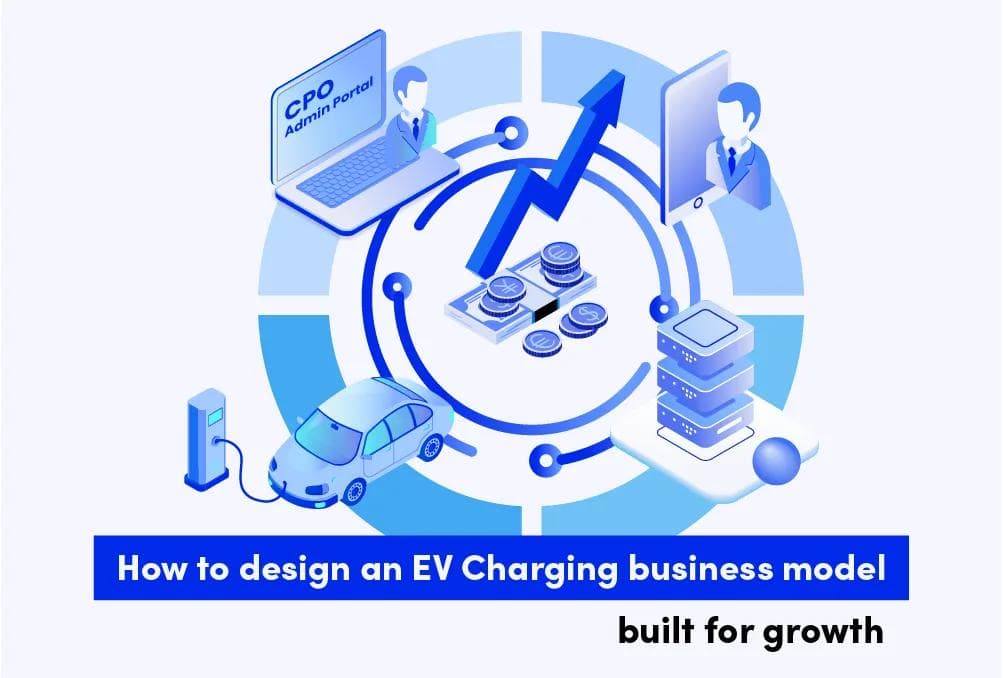Setting up an EV charging station sounds straightforward - install the equipment, connect to the grid, and start charging. But turning that setup into a sustainable, profitable business takes more than just hardware. You need a clear plan and a business model that works in the real world.
Whether you're exploring a new revenue stream, managing a fleet, or trying to make use of underutilized property, designing the right EV charging business model is what makes the difference between break-even and long-term growth.
This guide will help you build that model, from understanding costs and pricing to identifying key revenue opportunities.
What is an EV charging business model?
An EV charging business model is a plan for how your charging station generates revenue and stays financially viable. It defines what services you offer, who your customers are, how you price your charging, and how you manage your operating costs.
There’s no universal model that works for every location. A charger installed at a retail center will serve a different purpose and generate income differently than one at a highway rest stop or fleet depot.
Still, successful models tend to share a few fundamentals: clear revenue streams, smart cost management, and a focus on serving specific user needs.
This business model helps you answer important questions:
- Who are you targeting: everyday drivers, commercial fleets, or tenants?
- How will you price your services: per kWh, per minute, or flat rate?
- What level of charging infrastructure will you offer?
- How will you cover energy, maintenance, and network costs?
The rest of this article breaks down the essential components you’ll need to shape a charging business that can grow and scale.
Key elements of a profitable EV charging business model
Designing a business model that scales starts with understanding what drives profitability. Below are the key components to focus on when planning or refining your EV charging operation:
Revenue streams
You’re not limited to just charging drivers for power. A strong model often includes multiple income sources:
- Pay-per-use fees - Charge drivers per kWh, minute, or session.
- Subscriptions or memberships - Offer frequent users flat monthly rates or discounted access.
- Advertising and media - Monetize screens or charger space with branded content.
- Partnerships - Collaborate with retailers, fleets, or property owners to generate co-funded revenue.
- Grid services (V2G) - Participate in demand response or energy storage programs for utility incentives (future-facing).
Cost structure
Understanding your cost structure is critical to building a profitable EV charging business. On one hand you’ll know the upfront spend, but more importantly, you’ll know which investments will pay off as you scale.
CAPEX (Capital Expenditures)
These are the foundational investments that typically occur before launch:
- Hardware and installation
- Civil works (trenching, cabling, grid connection)
- Permits and certifications
- Software licenses for scalable, production-grade EMSP platforms
Licensing a modular, extensible platform is often classified as a capital expenditure, especially when it’s tied to long-term scalability and operational efficiency. Unlike custom builds, which can become resource-intensive and brittle at scale, licensed software enables faster deployment, stronger support through SLAs, and lower long-term maintenance overhead.
OPEX (Operational Expenditures)
Recurring costs associated with day-to-day operations include:
- Electricity consumption
- Routine maintenance
- Customer service and support
- Network and connectivity
- Payment processing fees
- Platform updates or optional integrations
A smart software investment early on often leads to lower OPEX over time by reducing the internal load of managing updates, integrations, and technical debt, giving teams more room to focus on growth.
Customer segments
Who you serve shapes how you operate:
- Individual drivers need convenient, easy-access charging with simple payment systems.
- Fleet operators require high-volume, repeat charging, often using fast-charging infrastructure.
- Commercial property owners, by incorporating chargers as a tenant/visitor amenity and a new revenue source, create added value for their customers.
Each segment has different expectations in terms of availability, speed, and pricing.
Charging station types
The type of charging you offer affects everything from cost to usage rate:
- Level 2 (AC)
Lower upfront cost, ideal for workplaces, residential, or long-dwell locations. - DC Fast Charging (Level 3)
Higher investment, faster turnover, great for highways or commercial fleets. - Mixed infrastructure
Combining L2 and L3 to balance cost-efficiency with customer convenience.
💡Tip: Mixed charging infrastructure also helps future-proof your business, allowing you to cater to today’s demand while staying ready for higher throughput needs as adoption grows.
Utilization strategy
Profit depends heavily on charger usage. A profitable model looks at:
- Site selection - High-traffic areas = higher utilization.
- Pricing incentives - Off-peak discounts or loyalty pricing.
- Smart charging tech - To optimize energy draw and reduce peak charges.
Driving profit through smart deployment
Choosing the right chargers is only part of the equation. To turn infrastructure into income, CPOs need to think strategically about where and how their stations are used.
This section covers the tactics that help maximize station usage and increase return on investment.
Site selection
The most powerful predictor of utilization is location. Stations near high-traffic areas or existing EV behaviors tend to see higher session volume:
- Retail parking lots
- Offices or co-working hubs
- Highway corridors
- Multi-unit residential buildings
Location strategy should balance expected dwell time with charger type. For example, a Level 2 charger makes sense where users stay longer (like workplaces), while DC fast charging performs best in short-dwell, high-turnover spots.
Dynamic pricing
Incentivize usage through time-based or demand-based pricing. You can:
- Offer lower rates during off-peak hours
- Charge premium rates during high-demand windows
- Create loyalty discounts or bundled services
This helps flatten demand curves and improve asset utilization without additional hardware investment.
Smart load management
Leverage software to:
- Distribute energy load across multiple chargers
- Avoid costly demand peaks
- Prioritize charging sessions based on user or fleet status
This not only improves operational efficiency but can also significantly reduce energy-related OPEX.
Boosting driver engagement
Profitability isn’t just about grid logistics. It’s just as important to be easy to find and use. Increase visibility and repeat use by:
- Listing stations on all major EV charging apps
- Ensuring real-time availability is accurate
- Offering perks like reserved spots or integrated parking + charging deals
Common challenges and how to avoid them
Building a profitable EV charging business takes more than hardware and a few good locations. Operators often run into friction as they scale, some of it technical, some financial, and some operational. Here are the most common pitfalls, and how smart CPOs work around them:
Underutilized stations
The problem: Low charger usage means longer ROI timelines and tighter margins.
How to avoid it:
- Prioritize high-traffic locations with predictable EV presence
- Use dynamic pricing to shape demand
- Ensure visibility on major charging networks and maps
Overbuilding too soon
The problem: Overspending on hardware or grid upgrades without established demand.
How to avoid it:
- Start lean, validate demand, then expand
- Use modular infrastructure and scalable software
- Explore co-investment or phased rollouts with partners
Custom software that becomes a bottleneck
The problem: Building your own CPO platform can feel like the ultimate control move, but that control often comes at a long-term cost. Custom software that worked for a handful of chargers can quickly become fragile, expensive, and hard to evolve as you scale.
What starts as flexibility can turn into technical debt:
- Internal teams get tied up maintaining backend tools instead of driving growth
- Scaling becomes riskier with every new feature or integration
- Bugs, regressions, and upgrade delays start cutting into operational efficiency
How to avoid it: The better question isn’t “should we build or buy?” - it’s “what kind of ownership model will still work when we’re 10x bigger?”
For most growth-focused CPOs, the answer lies in licensed, extensible CPO platforms:
- They provide a stable core infrastructure that’s ready to scale
- They allow you to build selectively around what truly differentiates your offering
- They reduce long-term maintenance overhead while keeping your team focused on strategy, not system upkeep
Pairing that with strong SLAs ensures uptime, predictability, and support without the need to staff like a software company. In short, you get the benefits of ownership without being on the hook for every line of code.
Poor energy cost management
The problem: High energy bills, especially during peak demand, can erode margins.
How to avoid it:
- Implement smart load balancing and peak shaving features
- Consider solar + storage where feasible
- Monitor energy use and align pricing to recover costs predictably
Slow time-to-market
The problem: Missed windows of opportunity due to long installation or tech deployment cycles.
How to avoid it:
- Choose sites with simpler permitting and grid access
- Work with partners experienced in eMobility deployments
- Avoid custom tooling for core infrastructure—use production-ready platforms that scale fast
These are the hurdles that separate well-positioned CPOs from those constantly in firefighting mode. With the right strategy and tools, many of these risks can be turned into opportunities for efficiency and long-term growth.
Ready to build smarter? Here's your next step
The foundation for designing a profitable EV charging business model is so much more than picking chargers or choosing locations. These are smart, scalable decisions that hold up as your network grows.
From site strategy and utilization to pricing and platform architecture, every choice shapes your long-term margins and operational flexibility. The good news? You don’t have to figure it all out manually or go it alone.
At Solidstudio, we help Charge Point Operators launch and grow smarter by offering a modular, license-based CPO platform that’s designed to scale. It gives you the strategic flexibility of ownership without the technical baggage of building everything from scratch.
Whether you're preparing for your first station or planning a multi-market rollout, the smartest move is starting with a business model built to scale.

